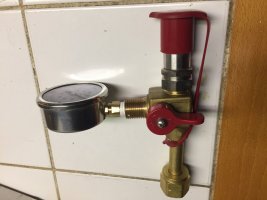UltimateWalrus
New Member
Hi! I’m a longtime owner of a ‘76 E29, recently upgraded to a ‘74 E35 which has been really excellently cared for. First time poster on this forum — was hoping I could get some general advice. I still have a lot to learn.
I’m at a crossroads with the E35. It came with a new LP gas stove/oven that hasn’t been installed. It has no existing propane system. I have looked up the logistics of safely installing propane, and it seems like an ordeal — at least 1000 in parts plus weeks of work (with lots of drilling through my boat’s hull). Rail-mounting the propane saves a bit of effort/expense but seems a bit questionable in heavy weather. I am reasonably handy, but am I correct in my assessment that retrofitting this boat for propane is going to be an expensive ordeal no matter what? Time is precious... so as cool as it would be to have a working oven on my boat, at this point I’m considering just selling the oven.
Also, there’s currently a mini fridge in the spot for the oven. If I put the oven there, then we’ll probably want to turn the ice box into the fridge, which looks like $1300 plus more work...
Has anyone retrofitted an Ericson with propane, and can help me guess as to expense and labor? It just doesn’t seem worth it from my perspective, but maybe I’m just being pessimistic. I’m guessing it would add a bit to the resale value, but it’s hard to guess.
Also... alternatively... does anyone know if it’d be reasonable for me to just get an inverter, and run the fridge and occasionally an electric range off two group 31 batteries? I don’t know if we are likely to do much long term cruising with this boat, though it’d be nice if we could last a week or so. I ideally wouldn’t want to run a generator more than an hour or two a day if I can help it.
I’m at a crossroads with the E35. It came with a new LP gas stove/oven that hasn’t been installed. It has no existing propane system. I have looked up the logistics of safely installing propane, and it seems like an ordeal — at least 1000 in parts plus weeks of work (with lots of drilling through my boat’s hull). Rail-mounting the propane saves a bit of effort/expense but seems a bit questionable in heavy weather. I am reasonably handy, but am I correct in my assessment that retrofitting this boat for propane is going to be an expensive ordeal no matter what? Time is precious... so as cool as it would be to have a working oven on my boat, at this point I’m considering just selling the oven.
Also, there’s currently a mini fridge in the spot for the oven. If I put the oven there, then we’ll probably want to turn the ice box into the fridge, which looks like $1300 plus more work...
Has anyone retrofitted an Ericson with propane, and can help me guess as to expense and labor? It just doesn’t seem worth it from my perspective, but maybe I’m just being pessimistic. I’m guessing it would add a bit to the resale value, but it’s hard to guess.
Also... alternatively... does anyone know if it’d be reasonable for me to just get an inverter, and run the fridge and occasionally an electric range off two group 31 batteries? I don’t know if we are likely to do much long term cruising with this boat, though it’d be nice if we could last a week or so. I ideally wouldn’t want to run a generator more than an hour or two a day if I can help it.

